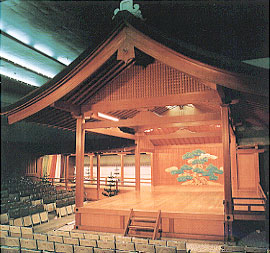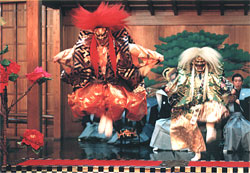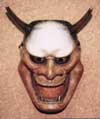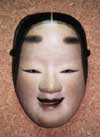 The current design of noh theaters became the norm in the early Meiji era (1868-1912). (Kyoto Kanze Kaikan) |
Another feature is that the leading actor usually wears a mask, turning them into someone very different: a very old man, young or old woman, divine figure, ghost, or young boy. So the mask is very important. Not everyone wears a mask, though. Those who play waki (supporting) roles--who are always living males--don't have to transform themselves, and so they never use a mask. Kyogen (comic) parts are usually male too, so they don't wear masks either.
Noh is performed on a special stage. The main area is a square measuring 5.4 meters each side. Extending to the left (when seen from the audience) from the back of the stage is the hashigakari, a corridor through which the main actors and musicians enter and leave; it's also used as a performing area.
 A scene from Sakkyo. Noh has some action-packed scenes like this. |
These areas are covered by a roof, so the stage looks like a house inside a building. The roof is there because noh used to be performed outdoors. It's only over the past one hundred years or so that indoor noh theaters have been built.
The stage is compact, but with areas where the chorus and musicians--two or three percussionists and a flutist--sit, it's very efficiently designed. There are some 260 plays in the noh repertoire. Many of them are drawn from ancient literary or historical texts. The language of noh plays is very beautiful and poetic, and the singing style is very distinctive.


